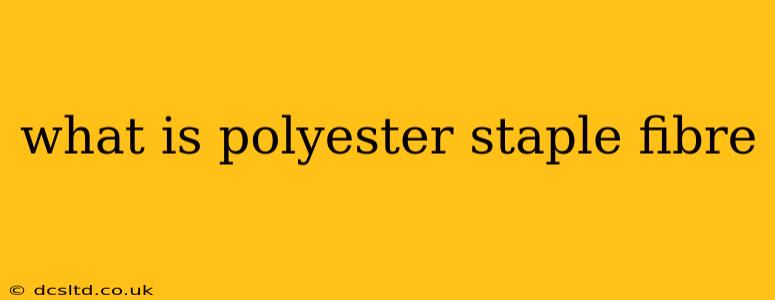Polyester staple fiber is a synthetic fiber, incredibly versatile and widely used in the textile industry. Unlike filament yarns, which are continuous strands, staple fibers are short, cut lengths of fiber, typically ranging from 38mm to 152mm (1.5 to 6 inches) in length. This seemingly small difference fundamentally changes the properties and applications of the material. Let's delve deeper into what makes polyester staple fiber unique and how it's used.
What are the properties of polyester staple fiber?
Polyester staple fiber boasts several advantageous properties that contribute to its popularity:
-
Strength and Durability: It's known for its high tensile strength, meaning it resists stretching and tearing, leading to long-lasting fabrics. This makes it ideal for clothing, upholstery, and other applications requiring resilience.
-
Resilience and Wrinkle Resistance: Polyester staple fiber is remarkably wrinkle-resistant, requiring less ironing and maintaining its shape better than many natural fibers.
-
Water Resistance: While not entirely waterproof, polyester exhibits good water resistance, making it suitable for outdoor clothing and applications where moisture is a concern.
-
Easy Care: It's relatively easy to care for, often machine washable and drying quickly. This low-maintenance aspect adds to its appeal.
-
Versatile Dyeing: It readily accepts dyes, enabling a wide array of colors and patterns. This versatility allows manufacturers to create a vast range of products.
-
Cost-Effective: Polyester staple fiber is generally more affordable than many natural fibers, making it a cost-effective choice for various applications.
What is the difference between polyester staple fiber and polyester filament?
The key difference lies in the fiber length. Polyester filament is a continuous, unbroken strand, often used to create smooth, shiny fabrics like satin. Polyester staple fiber, as discussed, is cut into short lengths. This difference affects the resulting fabric's texture and properties. Staple fibers create softer, more absorbent fabrics, while filament yarns are typically smoother and more lustrous.
How is polyester staple fiber made?
Polyester staple fiber is produced through a process of polymerization, where smaller molecules are linked together to form long chains. This process involves melting the polymer and extruding it through tiny holes called spinnerets. The resulting filaments are then cut into short lengths to create the staple fibers. Different processes and variations exist, leading to fibers with slightly differing properties.
What products use polyester staple fiber?
The applications of polyester staple fiber are vast and include:
-
Clothing: T-shirts, blouses, trousers, jackets, and many other garments often incorporate polyester staple fiber for its durability and easy care.
-
Home Furnishings: Upholstery fabrics, curtains, carpets, and bedding often utilize polyester staple fiber for its strength, resilience, and stain resistance.
-
Industrial Applications: It's used in various industrial applications, such as filter fabrics, geotextiles (used in construction), and other specialized products.
-
Blends: Polyester staple fiber is frequently blended with other fibers like cotton, wool, or rayon to enhance the properties of the resulting fabric. For instance, a blend of cotton and polyester can create a fabric that's both soft and durable.
What are the advantages and disadvantages of polyester staple fiber?
Advantages:
- Durability and strength
- Wrinkle resistance
- Water resistance
- Easy care
- Cost-effectiveness
- Versatile dyeing capabilities
Disadvantages:
- Can feel less soft than some natural fibers
- Not as breathable as natural fibers (can feel warm in hot weather)
- Can contribute to environmental concerns due to its synthetic nature (although recycling efforts are increasing)
Is polyester staple fiber sustainable?
The sustainability of polyester staple fiber is a complex issue. While it's a durable and long-lasting material, its production relies on petroleum-based resources and can generate environmental concerns. However, significant efforts are being made toward more sustainable production methods, including using recycled materials and developing bio-based alternatives. The long-term sustainability of polyester staple fiber depends on ongoing research and development in these areas.
This comprehensive overview should provide a clear understanding of polyester staple fiber, its properties, applications, and the ongoing discussions surrounding its sustainability. The versatility and cost-effectiveness of this material ensure its continued prominence in the textile industry, even as the industry adapts to more eco-conscious practices.
